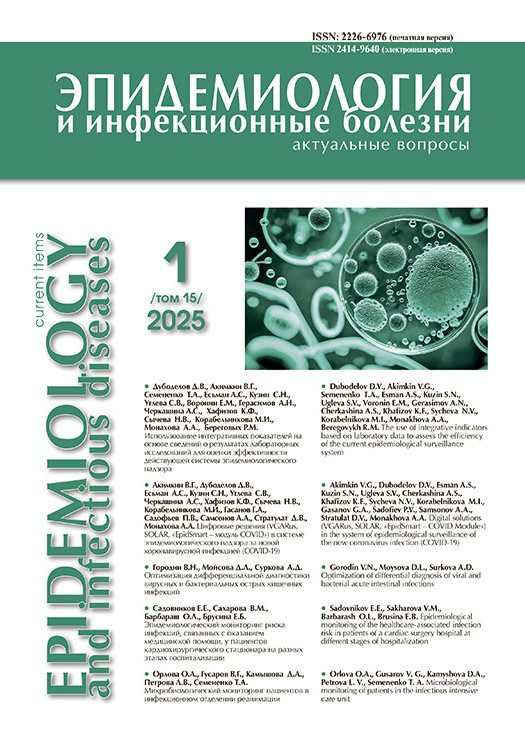Analysis of norovirus infection incidence in Omsk Region
DOI: https://dx.doi.org/10.18565/epidem.2025.15.1.24-28
Puzyreva L.V., Sivolapova O.N., Kuleshov K.V., Sergeeva V.V.
1) Omsk State Medical University, Omsk, Russia; 2) Office of the Russian Federal Service for Supervision of Consumer Rights Protection and Human Well-Being in Omsk Region, Omsk, Russia; 3) Central Research Institute of Epidemiology, Russian Federal Service for Supervision of Consumer Rights Protection and Human Well-Being, Moscow, Russia 4) Infectious Diseases Hospital for Children, A.N. Kabanov City Clinical Hospital № 1, Omsk, Russia
Materials and methods. Official reporting forms with epidemiological data for 2017–2023 were used.
Results. The region has been experiencing a consistently high rate of confirmed cases of viral intestinal diseases (from 82.6% to 91.8%) among the entire population of the region for 7 years. The share of NVI increased from 8.1 to 25.1%, while the frequency of registration of cases of the disease in persons under 17 years of age ranged from 70.0 to 79.1%. Norovirus gastroenteritis was registered in children of all ages. The highest rates were observed in the age group from 1 year to 6 years, while cases of the disease were more common in children attending preschool institutions. Among children over 7 years of age, the incidence of norovirus infection decreased. Seasonality for NVI in the Omsk region was typical.
Conclusion. Most often, NVI affects organized preschool children, mainly in the cold season. The increase in the incidence of viral intestinal infections requires an expansion of the spectrum and volume of diagnostic virological studies.
Literature
1. Chan M.C., Kwok K., Zhang L.Y., Mohammad K.N., Lee N., Lui G.C.Y. et al. Bimodal seasonality and alternating predominance of norovirus GII.4 and Non-GII.4, Hong Kong, China, 2014–2017. Emerg. Infect. Dis. 2018; 24(4): 767–769. DOI: 10.3201/eid2404.171791 2. Дмитриева Т.Г., Нестерева М.Е. Анализ инфекционной заболеваемости у детей в республике Саха (Якутия) с 2012 по 2021 гг. Вестник Северо-Восточного федерального университета им. М.К. Аммосова. Серия: Медицинские науки. 2023; 30(1): 37–46. DOI: 10.25587/SVFU.2023.30.1.001 Dmitrieva T.G., Nestereva M.E. [Analysis of infectious morbidity in children in the Republic of Sakha (Yakutia) from 2012 to 2021]. Vestnik of North-Eastern Federal University. Series: Medical Sciences. 2023; 30(1): 37–46. (In Russ.). DOI: 10.25587/SVFU.2023.30.1.001 3. Хохлова Н.И., Капустин Д.В., Краснова Е.И., Извекова И.Я. Норовирусная инфекция (обзор литературы). Журнал инфектологии 2018; 10(1): 5–14. DOI: 10.22625/2072-6732-2018-10-1-5-14 Hohlova N.I., Kapustin D.V., Krasnova E.I., Izvekova I.Ja. [Norovirus infection (literature review)]. Journal of Infectology 2018; 10(1): 5–14. (In Russ.). DOI: 10.22625/2072-6732-2018-10-1-5-14 4. Попова Р.В., Руженцова Т.А. Особенности течения и подходы к терапии норовирусной инфекции у детей. Лечащий врач 2018; (11): 44–48. Popova R.V., Ruzhencova T.A. [Features of the course and approaches to the treatment of norovirus infection in children]. Attending physician 2018; (11): 44–48. (In Russ.). 5. О состоянии санитарно-эпидемиологического благополучия населения в Омской области в 2023 году: Государственный доклад. Омск; 2024. Управление Федеральной службы по надзору в сфере защиты прав потребителей и благополучия человека по Омской области. 2023. 220 с. [On the state of sanitary and epidemiological well-being of the population in the Omsk region in 2023: State report]. Omsk: Office of the Russian Federal Service for Supervision of Consumer Rights Protection and Human Well-Being, in the Omsk Region, 2023. 220 p. (In Russ.). 6. Сергевнин В.И. Современные тенденции в многолетней динамике заболеваемости острыми кишечными инфекциями бактериальной и вирусной этиологии. Эпидемиология и Вакцинопрофилактика 2020; 19(4): 14–19. DOI: 10.31631/2073-3046-2020-19-4-14-19 Sergevnin V.I. [Current trends in the long-term dynamics of the incidence of acute intestinal infections of bacterial and viral etiology]. Epidemiology and Vaccine prevention 2020; 19 (4): 14–19. (In Russ.). DOI: 10.31631/2073-3046-2020-19-4-14-19 7. Черепанова Е.А., Симонова Е.Г., Раичич Р.Р., Линок А.В., Филатов Н.Н. Оценка эпидемиологического риска в системе эпидемиологического надзора за актуальными для Российской Федерации острыми кишечными инфекциями. ЗНиСО. 2018; (3): 23–28. DOI: 10.35627/2219-5238/2018-300-3-23-28 Cherepanova E.A., Simonova E.G., Raichich R.R., Linok A.V., Filatov N.N. [Assessment of the epidemiological risk in the system of acute intestinal infections'epidemiological surveillance in the Russian Federation]. Public Health and Life Environment 2018; (3): 23–28. (In Russ.). DOI: 10.35627/2219-5238/2018-300-3-23-28 8. О состоянии санитарно-эпидемиологического благополучия населения в Российской Федерации в 2023 году: Государственный доклад. М.: Федеральная служба по надзору в сфере защиты прав потребителей и благополучия человека, 2024. 364 с. [On the state of sanitary and epidemiological well-being of the population in the Russian Federation in 2023: State report]. Moscow: Federal Service for Supervision of Consumer Rights Protection and Human Welfare, 2024. 364 p. (In Russ.). 9. Попова Р.В., Руженцова Т.А. Внекишечные проявления норовирусной инфекции у детей. Эпидемиол. инфекц. болезни. Актуал. вопр. 2018; (4): 67–71. DOI: 10.18565/epidem.2018.4.67-71 Popova R.V., Ruzhencova T.A. [Extraintestinal manifestations of norovirus infection in children]. Epidemiology and infectious diseases. Current items 2018; (4): 67–71. (In Russ.). DOI: 10.18565/epidem. 2018.4.67-71 10. Сергевнин В.И. О причинах сезонности эпидемического процесса ротавирусной, норовирусной и энтеровирусной инфекций. Эпидемиология и Вакцинопрофилактика 2020; 19(6): 74–78. DOI: 10.31631/2073-3046-2020-19-6- 74-78 Sergevnin V.I. [On the causes of the seasonality of the epidemic process of rotavirus, norovirus and enterovirus infections]. Epidemiology and Vaccine Prevention 2020; 19(6): 74–78. (In Russ.). DOI: 10.31631/2073-3046-2020-19-6-74-78 11. Hayek H., Amarin J.Z., Qwaider Y.Z., Khanfar A., Stopczynski T., Schmitz J. et al. Co-detection of respiratory syncytial virus with other respiratory viruses across all age groups before and during the COVID-19 pandemic. Virology 2023; (3): 1156012. DOI: 10.3389/fviro.2023.1156012
About the Autors
Larisa V. Puzireva, МD, Associate Professor, Head, Department of Pediatric Infectious Diseases, Omsk State Medical University, Ministry of Health of the Russia , Omsk, Russia; puzirevalv@mail.ru; http://orcid.org/0000-0003-0495-3645
Olga N. Sivolapova, Chief Specialist-Expert of Epidemiological Surveillance, Office of the Russian Federal Service for Surveillance on Consumer Rights Protection and Human Well-Being in Omsk Region, Omsk, Russia; Yason_1970@mail.ru; http://orcid.org/0009-0007-2502-7372
Konstantin V. Kuleshov, Cand. Biol. Sci., Head, Laboratory of Molecular Diagnostics and Epidemiology of Intestinal Infections, Central Research Institute of Epidemiology, Russian Federal Service for Supervision of Consumer Rights Protection and Human Well-Being Moscow, Russia; konstantinkul@gmail.com; http://orcid.org/0000-0002-5238-7900
Victoria V. Sergeeva, Pediatrician, Infectious Diseases Hospital for Children, A.N. Kabanov City Clinical Hospital № 1, Omsk, Russia; lupanova2123@mail.ru; http://orcid.org/0009-0006-6636-073X


